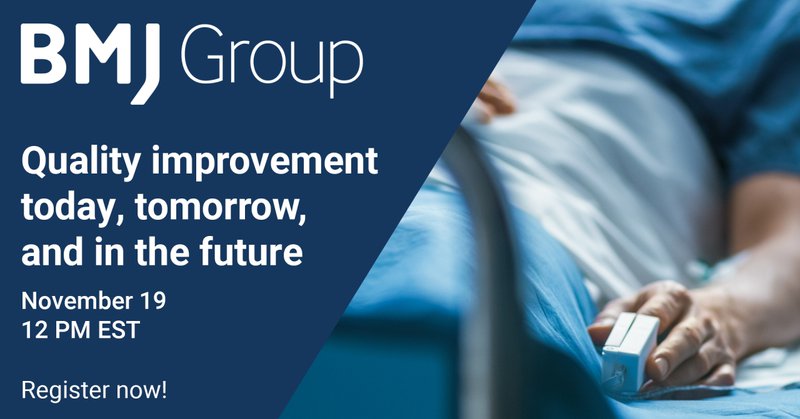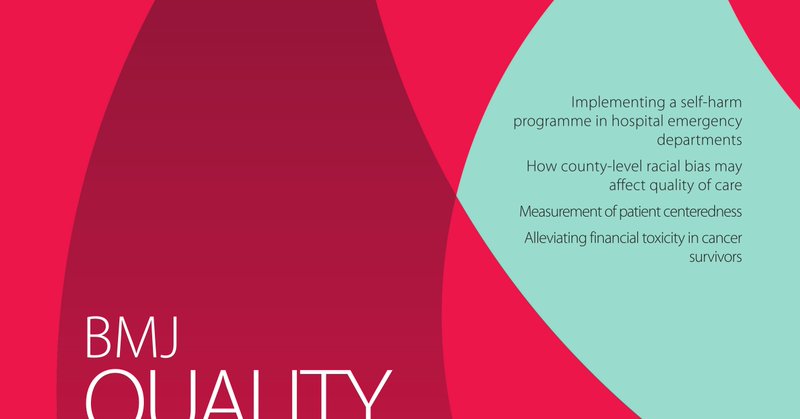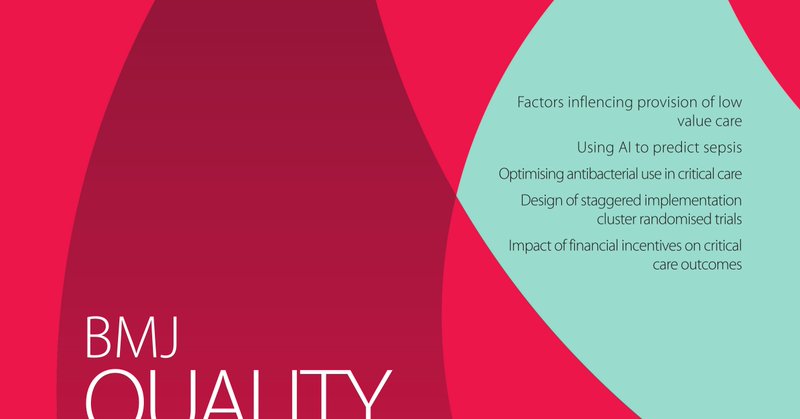
BMJ Quality & Safety
@BMJ_Qual_Saf
Followers
16K
Following
872
Media
319
Statuses
4K
Publishing the best research for the quality & safety in healthcare community. Companion #OpenAccess journal, @BMJOpenQuality. Published with @HealthFdn.
London, UK
Joined April 2010
In this editorial, @JBryanSexton1 & Jochen Profit argue for a coordinated healthcare worker well-being movement - like the Patient Safety Movement before it. They reflect on @anna_melvin_ et al’s study ( https://t.co/fPigGJ82zN) and propose further key requirements for
0
1
1
🩺 Doctors' well-being is essential for safe, high-quality care, but poorly designed support can do more harm than good. This realist study across 8 hospitals found: 1️⃣ Well-being solutions need to align with problems 2️⃣ Doctors should be involved in creating solutions 3️⃣
0
5
3
💬 Can a simple patient portal message prompt people with poorly controlled diabetes to get follow-up testing? In this randomised trial of >2500 patients, a single portal message did not significantly increase HbA1c testing within 90 days but did improve patient engagement with
0
0
0
This implementation research study describes how the NEST360 alliance applied quality improvement (QI) and implementation science to improve newborn care in sub-Saharan Africa. 📊 Key results: ✅ 100% of units launched a QI project ✅ 100% logged into the NEST-IT system ✅ 93%
0
1
3
A Canadian ICU quality improvement initiative which introduced a standard tracheostomy weaning protocol: ✅ reduced median ventilator time from 17 to 10.6 days ✅ shortened ICU stay by 4.3 days ✅ protocol adherence improved over time. Read more: https://t.co/AIaJVZ8FKJ
0
0
2
Discover the future of quality improvement! Join our colleagues @BMJBestPractice for a free webinar, “Quality Improvement: Today, Tomorrow, and the Future.” 📆 November 17 — Reserve your spot now! https://t.co/HUQi29kKaV
bmj.wistia.com
Join us for a forward-thinking discussion on the future of Quality Improvement (QI) with two leading experts in the field: Dr. Patricia Henwood of Jefferson Health and Dr. Kieran Walsh of BMJ. A...
0
0
0
A systematic review of structured handoff protocols in acute care hospital units identified moderate-certainty evidence supporting the effectiveness of the I-PASS protocol, and low-certainty evidence for the SBAR protocol, in improving patient safety outcomes. Learn more here
qualitysafety.bmj.com
Background Handoffs are a weak link in the chain of clinical care of inpatients. Within-unit handoffs are increasing in frequency due to changes in duty hours. There are strong rationales for...
0
2
7
The PRrevention of Cerebral palsy in PreTerm labour (PReCePT) programme, an evidence-based quality improvement intervention, boosted antenatal magnesium sulfate use in England from 66% to 86% over 5 years. Using a quasi-experimental design, @HannahB_Edwards, @KarenLuyt &
0
4
6
In this viewpoint, @terylnuckols explores how published economic evaluations could better meet the information needs of organisational leaders and align with the capabilities of Quality Improvement teams seeking to publish their work. https://t.co/dKe8CdH9n8
0
1
3
In their editorial, Jackson & Shortliffe emphasize the importance of evaluating AI in healthcare by considering technical performance, integration into clinical workflows, and real-world impact. In reference to Tabuchi et al.'s study on an AI-powered surgical safety system
0
0
1
In Japan, an AI-based surgical safety system in ophthalmology helped prevent errors in patient identification, surgical laterality, and intraocular lens selection. In real-world use, it increased near miss detection and showed potential economic benefits. Read more here:
0
2
6
🔍 After experiencing harm in the NHS, people often seek explanations, apologies & support—but face many barriers. In this qualitative study, @LavanyaThana & colleagues explored how people respond to harm, and what drives or prevents formal action. Findings highlight the need
qualitysafety.bmj.com
Objectives To capture experiences of people self-reporting harm and contrast responses and actions between those who do or do not take formal action. Design Semi-structured qualitative interview...
2
6
8
🔍 A national survey of 10,000+ people found nearly 1 in 10 reported harm from NHS care or lack of access in the past 3 years. Most wanted support to redress the harm or an explanation, but few were satisfied with complaints processes. Experiences and responses varied across
0
4
3
🚨 Many hospitals use fall prevention alarms despite limited evidence they work. @TurnerKea and colleagues had hospital staff brainstorm, rate, and sort strategies to deimplement these alarms, helping to create tailored implementation packages for each site. Read more:
qualitysafety.bmj.com
Objectives Many hospitals use fall prevention alarms, despite the limited evidence of effectiveness. The objectives of this study were (1) to identify, conceptualise and select strategies to deimpl...
0
1
1
🧑⚕️💻 A randomised trial tested ways to reduce unnecessary CT scans for low-risk neck trauma in emergency departments. Digital audit-and-feedback reduced overuse by ~1.3 scans per provider per month. Hybrid feedback showed similar improvements but was not significant and
0
0
1
🤖 A sepsis prediction model tested across 9 hospitals showed varying accuracy between emergency departments and wards. ⚖️ Training separate models for emergency and ward patients reduced false alarms and improved alert precision. 🚨 Customizing models by care location helps
qualitysafety.bmj.com
Objective To identify bias in using a single machine learning (ML) sepsis prediction model across multiple hospitals and care locations; evaluate the impact of six different bias mitigation strateg...
0
0
2
In this editorial, Meg Morris discusses Cho et al’s study on under-reporting of falls in Korean hospitals ( https://t.co/G4bXgw1v8x), highlighting how system gaps, inconsistent definitions, and variable reporting practices hinder fall prevention efforts. https://t.co/kabDAhmtjm
0
0
0
🔍 This retrospective study by @dbatessafety and colleagues in four South Korean hospitals found wide variation in fall definitions, risk assessment tools, and prevention practices. ⚠️ Many at-risk patients did not receive tailored interventions, and fall events were often
0
0
0
🌍 World Patient Safety Day 2025 focuses on “Safe Care for Every Newborn and Every Child,” underscoring the critical importance of safety in maternal and child health. BMJ Quality & Safety invites submissions of original research, quality improvement reports, viewpoints,
0
1
2
📊 A newly developed ratio model improves measurement of guideline concordance at the individual patient level by factoring in past clinical activities and their timing. ✅ Tested in type 2 diabetes, it provides accurate and patient-centred guideline concordance scores which can
0
0
2




